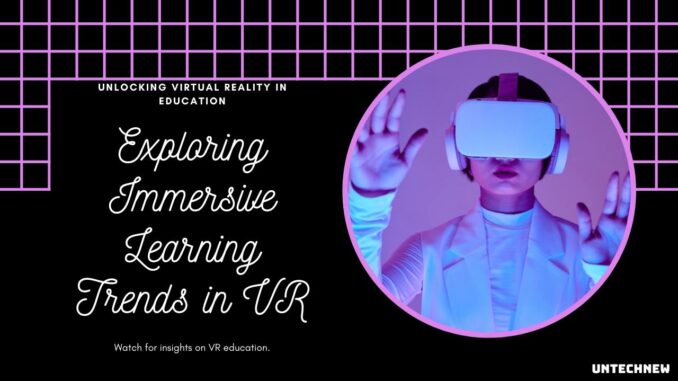
Introduction:
Virtual Reality (VR) technology has emerged as a powerful tool in education, revolutionizing the way students learn and interact with course material. By immersing students in realistic and interactive virtual environments, VR offers a unique opportunity to enhance learning outcomes, engage students in immersive experiences, and foster creativity and critical thinking. In this article, we’ll explore the applications of virtual reality in education, its potential benefits, challenges, and the evolving trends shaping immersive learning experiences.
The Rise of Virtual Reality in Education
Virtual Reality technology has rapidly gained traction in education, transforming traditional teaching methods and expanding the possibilities for immersive learning experiences. VR applications in education span a wide range of disciplines, from STEM subjects such as biology, physics, and engineering to humanities, arts, and social sciences. By simulating real-world scenarios and environments, VR enables students to explore concepts, conduct experiments, and engage in hands-on learning activities in ways that were previously impossible.
Applications of Virtual Reality in Education
- Immersive Experiences: VR technology allows students to explore virtual environments that replicate real-world scenarios, historical settings, or scientific phenomena, providing immersive learning experiences that enhance understanding and retention.
- Virtual Laboratories: VR simulations enable students to conduct experiments and simulations in virtual laboratories, allowing for hands-on learning experiences without the need for physical equipment or resources.
- Field Trips and Excursions: Virtual field trips allow students to visit historical landmarks, cultural sites, or natural habitats from the comfort of their classroom, expanding their understanding of the world and fostering a sense of curiosity and exploration.
- Interactive Storytelling: VR storytelling experiences immerse students in interactive narratives and simulations, allowing them to engage with characters, explore plotlines, and make decisions that shape the outcome of the story.
- Skill Development: VR applications can be used to develop practical skills such as communication, problem-solving, teamwork, and decision-making through interactive scenarios and simulations.
- Accessibility and Inclusion: VR technology has the potential to make education more accessible and inclusive for students with disabilities or learning differences by providing alternative learning environments and experiences tailored to individual needs.
Benefits of Virtual Reality in Education
The integration of virtual reality technology in education offers a range of benefits for students, educators, and institutions:
- Enhanced Engagement: VR immerses students in interactive and realistic environments, increasing engagement, motivation, and interest in learning.
- Improved Learning Outcomes: Studies have shown that immersive learning experiences facilitated by VR technology can lead to improved learning outcomes, including increased retention, understanding, and application of knowledge.
- Personalized Learning: VR allows for personalized learning experiences tailored to individual learning styles, preferences, and needs, enabling students to learn at their own pace and in their own way.
- Hands-On Learning: Virtual simulations and experiences provide hands-on learning opportunities that are otherwise impractical or impossible in traditional classroom settings, allowing students to explore, experiment, and learn by doing.
- Global Collaboration: VR enables students and educators to collaborate and communicate in virtual environments regardless of geographical location, fostering global connections and cross-cultural understanding.
- Cost-Efficiency: While initial investments in VR technology may be significant, virtual reality can ultimately reduce costs associated with traditional teaching methods, such as field trips, laboratory equipment, and physical resources.
Challenges of Implementing Virtual Reality in Education
Despite its potential benefits, the integration of virtual reality technology in education presents several challenges:
- Cost and Accessibility: The high cost of VR hardware and software may pose a barrier to widespread adoption, particularly for schools and institutions with limited budgets.
- Technical Requirements: VR technology requires robust hardware, software, and infrastructure to function effectively, including powerful computers, VR headsets, and reliable internet connectivity.
- Content Development: Creating high-quality VR content and experiences can be time-consuming, resource-intensive, and technically complex, requiring specialized skills and expertise.
- Training and Support: Educators may require training and support to effectively integrate VR technology into their teaching practice, including technical training, pedagogical guidance, and ongoing professional development.
- Ethical Considerations: VR raises ethical concerns related to privacy, safety, and data security, particularly when used with children and vulnerable populations.
- Digital Divide: The digital divide—inequalities in access to technology and digital literacy skills—may exacerbate existing disparities in education, limiting access to VR experiences for underserved communities and populations.
Future Trends in Immersive Learning
As VR technology continues to evolve, several trends are shaping the future of immersive learning:
- Mobile VR: Advancements in mobile VR technology are making VR experiences more accessible and affordable, allowing students to access immersive learning experiences using smartphones and lightweight VR headsets.
- Social VR: Social VR platforms enable students and educators to interact and collaborate in virtual environments, fostering community, connection, and engagement in immersive learning experiences.
- Augmented Reality (AR): Augmented Reality technology, which overlays digital information onto the physical world, is complementing VR in education, offering new opportunities for interactive learning experiences and real-world applications.
- Data Analytics and AI: Data analytics and Artificial Intelligence (AI) technologies are being integrated into VR platforms to track student progress, personalize learning experiences, and provide real-time feedback and recommendations.
- Immersive Assessment: VR is being used for immersive assessment and evaluation, allowing educators to assess student learning and performance in authentic and realistic contexts.
- Global Collaboration: VR is facilitating global collaboration and cultural exchange in education, connecting students and educators from diverse backgrounds and locations in shared virtual learning environments.
Conclusion
Virtual Reality technology is revolutionizing education, offering immersive learning experiences that engage students, enhance learning outcomes, and foster creativity and critical thinking. While challenges such as cost, accessibility, and content development remain, the potential of VR in education is vast and transformative. As VR technology continues to evolve and become more accessible, it holds the promise of creating a more engaging, inclusive, and effective learning environment for students worldwide. By embracing VR as a tool for immersive learning, educators can unlock new possibilities for teaching and learning that transcend the boundaries of the traditional classroom.

Leave a Reply